Droughts can be tough on farmers, farms and their animals. Unfortunately, with climate disruption, they may become more frequent. They are also predicted to occur in regions that have been previously be seen as summer-safe.
The good news is that, with good drought management, young females will reach mating weights on time and hinds will have a good fawning next season. Stags will continue to produce great velvet.
To do this, it’s important for farmers to take control of their situation and to have a plan for what they will do if the drought continues. They also need to ensure they have enjoyable activities and social engagement off their farm. Good mental health is essential for surviving – and ideally thriving in – the stress of the dry.
When drought is predicted, or when things become unusually dry, act promptly.
- Make a plan for your feeding and animal management.
- Keep a record of your plan and the decisions you make. This will be useful when you are managing future droughts.
- Check your water supply and monitor it daily. A good supply of clean water is essential for stock welfare and survival. If you have a tank-based system, consider investing in an electronic monitoring system (see photo below). Consider building redundancy into the system, so that if one water source fails, you always have back-up.

- Take heart. With good nutrition, it is possible to meet deer production targets in a drought.
- Make sure you have (or can access) more baleage, red clover or lucerne hay, or other bulk feeds than you are likely to need. Once drought sets in, bought-in feed becomes more costly and supplies may become tight. See Feeding supplements (below).
- Limit the impact of the drought on stock to the current season. Well-fed young females will reach mating weights on time. Well-fed breeding stock will give you a good fawning next season.
- Limit the impact on pastures to the current season. ‘Gently’ manage paddocks that are likely to survive the drought. Off-farm grazing may be an option for young capital stock.
- As the season progresses, keep control of the situation by making decisions based on your plan.
- Drought is stressful. Keep in contact with other deer farmers. Take time to relax off the farm and keep making decisions (be positive).
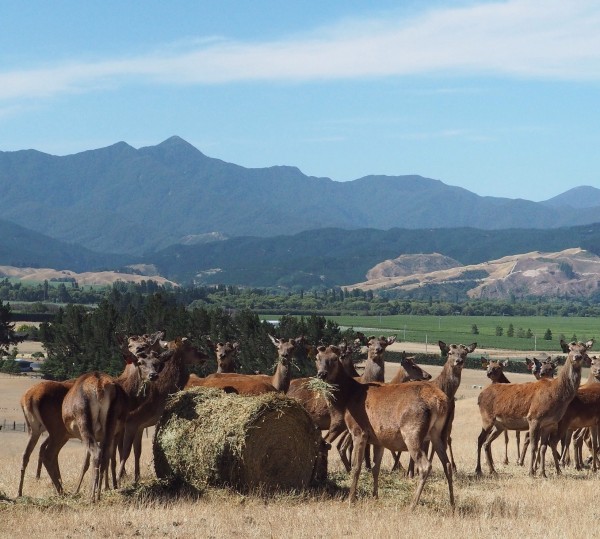
Red stags having a treat at the Shewans’ Wairau Valley, Marlborough farm. They’ll be enjoying lucerne hay until the next truck load of baleage arrives
- Progressively reduce stock numbers, starting with non-capital stock, such as early lambs and store cattle. Then cull some of your older breeding hinds and poorer yearling hinds.
- In a spring drought, send all finishing deer to the processor in November whether or not they have reached target weights.
- Check velvetting stag records for early culling. Do you need so many yearling stag replacements?
- With older stags, it may pay to send culls to the processor after their first cut, rather than waiting for regrowth. From 20 February they cannot be trucked until the roar is over.
- Before weaning, feed silage and grain to hinds and fawns. This will support lactation and hind condition and get fawns used to this form of feeding. Monitor the BCS or weights of a selection of each mob to ensure they are getting enough feed. To ensure good conception and fawning rates, they must be at least maintaining their condition when they go to the stag.
- Wean early (in mid-February) if there is quality feed available for fawns. Give weaners and young stock priority access to this feed. Don’t wean earlier than mid-February because fawns will still be dependent on their mothers.
Early weaning will reduce feed demand by 12-20% and will allow hinds to start recovering condition before going to the stag.
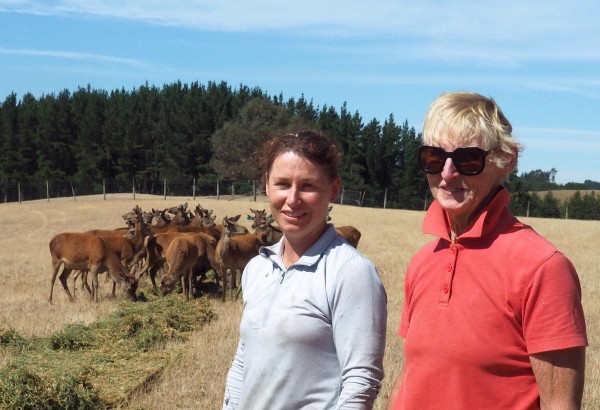
Deer farmers Giselle and Marilyn Shewan plan for drought; buying in feed well before it’s needed. “We don’t want to thrash the paddocks, so we start feeding out well before the grass has gone.” Photo: Trevor Walton
Once the dry begins, start feeding out. The earlier the better. Aim to retain roughage in the paddock for as long as possible.
Ideally, they won’t eat it out completely, as grasses store their energy above ground. This will help power regrowth when the drought breaks.
Think about putting your paddocks into three categories:
- Those that will survive a drought.
- Those that are possible survivors
- Those that will not survive.
Try not to graze category 1 paddocks out. The fate of category 2 paddocks will depend on the severity of the drought and how long it lasts. Use category 3 paddocks for feeding out.
Have a plan for re-sowing category 3 paddocks when the drought breaks. Under-sowing or direct drilling with winter cereals or annual ryegrass may be a good way to build a bank of quality winter/early spring feed.
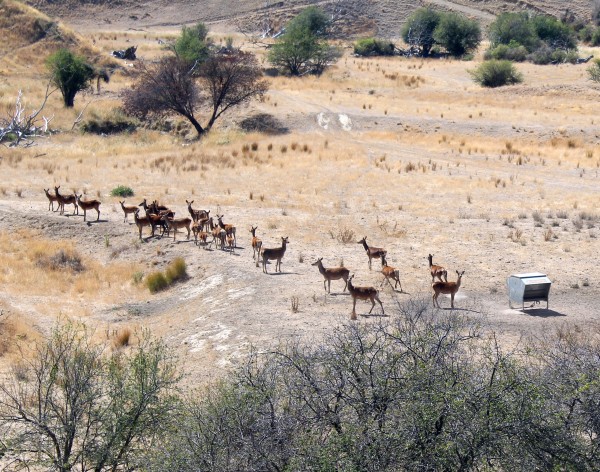
Many farmers get good results from supplementing silage or baleage with concentrates, using Advantage feeders (pictured bottom right). Photo: Justin Stevens
Feed supplements with the aim of preventing weight loss. Much less feed is needed to maintain weight than to regain it once it has been lost.
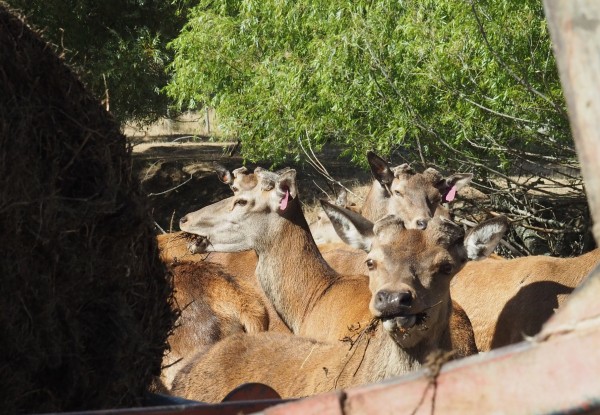
Stags can’t wait to have their share of red clover baleage on the Rentouls’ upper Wairau Valley, Marlborough, deer farm
If you are likely to need to buy in supplements, do so early. Prices will inevitably increase and supply may become difficult if the drought is prolonged.
Think ahead. Your breeding hinds may be OK on the hills in January, but will they need high protein supplements – such as nuts, peas, linseed, soya meal etc – in the lead-up to mating?
The Feed Cost Comparer on the Deer Hub, a web-based tool, makes these calculations easy.
You can also do your own calculations by multiplying the ME (metabolisable energy) value of the feed by its DM (dry matter) percentage so you can compare like with like. A medium energy supplement like PKE (palm kernel expeller) or a high energy grain like barley or maize is often more cost-effective than baleage or hay.
Depending on relative values, it might pay to sell some of your baleage and buy in grain or PKE. But don’t sell all your baleage! Grain should not exceed 60% of an animal’s ME requirements. Also, some markets are sensitive about the feeding of PKE, so check with your venison marketer before buying it in.
Introduce grain or PKE to the diet gradually (starting at 25-50 grams a day) to give time for the rumen to adjust.
To reduce the risk of bossing and overloading when feeding grain/PKE on the ground, spread it out so that all animals get their share. Remove bullied animals to a distress mob and manage them separately.
If you can’t source feed or off-site grazing, contact Federated Farmers or DINZ. They may be able to find a farmer who can help you.
To calculate how much feed to give to hinds and weaners, go to the Feed Intake Calculator on the Deer Hub. It is an excellent tool that’s easy to use. It adjusts rations as animal needs change with the season.
For Justin Stevens’ tips for using Advantage feeders, see the ‘Drought feeding and management’ Deer Fact.
After it rains, avoid grazing recovering pastures as soon as some growth appears. Continue to feed supplements. This will give time for pastures time to recover and for winter feed reserves to build. If you graze pastures below 1000 kg DM/ha you will reduce their growth by up to 25%.
Beware: as grass growth recovers in warm damp conditions, populations of parasite larvae on pasture will increase rapidly. A parasite control plan will be needed for your young deer. Check out the Parasites information on the Deer Hub and ask your vet about the latest parasite control options.

De-stressing is crucial during a drought. Getting exercise off the farm by surfing or by playing other sports is a proven tonic –especially if it involves a few laughs with family and friends
Droughts are stressful. Don’t be staunch and try to battle the blues in silence. Some tips:
- Network with other deer farmers. Share your worries with them or a friend
- Have fun and laughter with family and friends
- Eat well, go easy on alcohol, get enough sleep
- Get exercise off the farm by playing sport, biking, swimming, surfing, tennis, tramping, hunting etc
- If stress-related issues are not going away, talk to your GP, or local Rural Support Trust, Freephone 0800 787 254. The Trust can put you in contact with personal and business advisers, and can negotiate with your bank if you are in financial difficulty.
The Beef + Lamb Dry Toolkit has some excellent advice on managing the stress of drought.
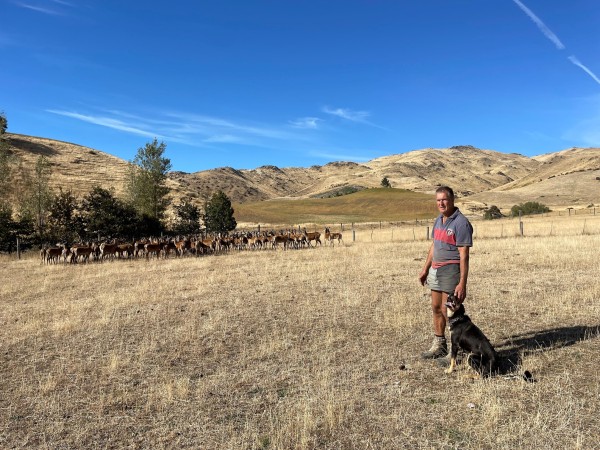
North Canterbury farmer Lyndon Matthews says their farm is pretty well set up for a one-off drought. “Things become more difficult when we have two droughts in a row.” Photo: Puketira Deer
Forecasters like NIWA are getting better at predicting droughts. Keep a watch on niwa.co.nz/climate for their seasonal climate updates.
With droughts predicted to become more frequent and more widespread, some farmers are now drought-proofing their farms.
Lyndon & Millie Matthews of Puketira Deer, North Canterbury, farm in a summer dry environment. They say their philosophy is simple, “If you can’t feed the animals properly you need to get rid of them,” says Lyndon.
“Our aim is to make sure our deer stay in good condition, regardless of the drought. We want it to be business as usual once the drought breaks.”
Farming system changes to consider
- Growing summer crops, such as forage brassicas and fodder beet. These are a useful form of drought insurance, but they need to be established early in order to be useful in a drought. To give their rumens time to adjust, introduce deer to forage brassicas over 7-10 days. With fodder beet, 14-21 days. Because fodder crops are low in fibre and protein, supplement deer with about 1 kg/head/day of quality baleage or lucerne hay.
- Have a proportion of your stock units – say 25% -- as trading stock. Destocking by selling store lambs and cattle means you don’t have to sell or slaughter prized breeding stock.
- Reduce your overall stocking rate, so you are slightly understocked in an average year. If you are overstocked at present, you may find a (say) 10% reduction in your stocking rate has little or no effect on farm production. Having fewer animals also means the system will be under less stress if you can’t get killing space for your culls.
- Plant part of the farm in drought-tolerant, nutritious, summer growing species like lucerne, chicory and plantain. These crops boost growth rates in fawns and weaners, making these crops profitable even in normal years.
- Plant fodder trees in rough corners and on slip-prone slopes. Japanese fodder willow, Matsudana willow and Lombardy poplars are easy to establish, grow fast and make excellent drought feed. Branches can be direct grazed by deer, cut and carried to the animals, or put through a chipper and fed.
DINZ Deer Fact: Drought feeding and management
DINZ Deer feed requirements
DINZ Feed Cost Comparer
DINZ Feed Intake Calculator
MPI Dealing with Drought Conditions
Beef + Lamb NZ Extreme Dry Toolkit

